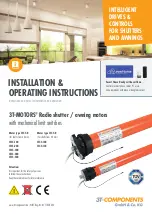
9
– English
––– GROUP “D” PROCEDURES ––
done exclusively with a smartphone with NFC (Near Field Communication)
NOTES AND WARNINGS
The programming with the “NFC” technology is not yet available on this motor. For more information contact the Nice Technical Assistance.
Using a smartphone equipped with NFC technology and a software application produced by Nice (to be installed on your smartphone), you can configure the motors
before installing them, even without the need to supply power. You can also perform a hardware and software diagnostic of the motor, even if it is damaged.
D
WARNINGS FOR NORMAL OPERATION
OF THE AUTOMATION
5
5.1 - Opening, closing and stopping the awning
In general, the awning is operated by pressing the button corresponding to the de-
sired movement:
s
= open;
t
= close;
n
= stop. In particular, if using a button panel,
refer to the programming done by the installer with procedures A.5 and A.7.
5.2 - Partially opening/closing the awning (height
“H”)
If the first intermediate awning position has been programmed (using procedure A.3),
before you can command it from a wall-mounted push button panel, you need to set
the functioning of the panel to
option “E”
during procedure A.5.
If additional intermediate awning positions have been programmed, these can only
be commanded using the DMBM module over the T4 BUS.
5.3 - Enabling (or disabling) by the user of automat-
ic commands sent by cabled climate sensors
Commanding the motor using the DMBM module over the T4 BUS, you can enable
or disable the motor’s reception of automatic commands from any climate sensors in
the system (sent by T4 bus or TTBUS cable) .
Users can choose whether to
enable
(with the
key) or
disable
(with the
key) re-
ception of automatic commands transmitted by climate sensors to the motor. In brief,
–
if reception is enabled
(button
) the motor will operate
automatically
;
–
if reception is disabled
(with button
) the motor will operate
manually
.
When reception is enabled, the user can send manual commands at any time: these
override the automatic operation of the automated device. When reception is disa-
bled, the automated device operates exclusively with the manual commands sent
by the user.
––– DEFINITIONS –––
• “Over-threshold” intensity of sun/wind
= a condition in which the atmospheric
phenomenon stands at values that are above the value set as threshold.
• “Under-threshold” Intensity of sun/wind
= a condition in which the atmospheric
phenomenon stands at values ranging from zero to half of the value set as thresh-
old.
TABLE B
climate condition...
over-threshold
under-threshold
With the motor
in “AUTOMAT-
IC” mode
(ena-
bled with button
) ...
... if the user
sends the com-
mand “
Sun-On
”
(with button
):
• the awning
makes 2 move-
ments and re-
mains in the
above-threshold
position.
• the system re-
starts the timer.
• the awning
makes 2 move-
ments and re-
mains in the un-
der-threshold po-
sition.
• the system re-
starts the timer.
... if the user
sends the com-
mand “
Sun-Off
”
(button
):
• the awning
makes 2 move-
ments.
• the awning
makes 2 move-
ments.
With the motor
in “MANUAL”
mode (enabled
with button
) ...
... if the user
sends the com-
mand “
Sun-On
”
(with button
):
• the awning
moves to the
above-threshold
position.
• the system re-
starts the timer.
• the awning
moves to the un-
der-threshold po-
sition.
• the system re-
starts the timer.
... if the user
sends the com-
mand “
Sun-Off
”
(button
):
• the awning
makes 2 move-
ments.
• the awning
makes 2 move-
ments.
5.3.1 - Behaviour of the motor in the presence of “Sun” sensor
• When the intensity of the sunlight reaches the over-threshold, after 2 minutes from
the beginning of this condition the motor autonomously performs a down move-
ment.
• When the intensity of the sunlight reaches the under-threshold, after 15 minutes
from the beginning of this condition the motor autonomously performs an up move-
ment.
Note
– Momentary drops in solar intensity, lasting less than 15 minutes, are not de-
tected. The manual commands of the user always remain active and are added to
those generated automatically by the system.
5.4 - “Obstacle detection” function
This function is a safety feature which trips automatically when the movement of the
awning, up or down, is blocked by an obstacles (physical object, person). The motor
immediately stops the movement in progress and performs a brief inversion of the
motion (if programmed to do so, see procedure A.6).
5.5 - Reoptimising the limit switch positions
It is normal for limit switch positions to move by a few mm or cm over the days fol-
lowing installation. This may be due to the awning’s or frame’s material settling or
bedding in; this often causes the awning to droop or go out of alignment with nearby
awnings. In such cases, if the head of the motor is accessible, you can very easily re-
optimise either or both of the limit switch positions with procedure B.1.
5.6 - “Automatic limit switch
update” function
Caution!
– This function is only available if the limit switches have been programmed
with the Semiautomatic procedure (par. A.2). This function cannot be disabled.
In ordinary use, the function activates automatically during an Up movement, when
the awning collides with the box or other mechanical stop (Up limit switch “0”). On
each collision, the function measures the position of the Up limit switch and memo-
rises the new value in place of the previous one. Over time, this compensates for
deformations in the structure due to wear and thermal cycles, so that the awning
always stops precisely at the Up limit position.
































